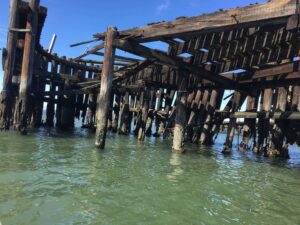From November to February this past winter, biologists scoured lower Russian River tributaries in search of spawning coho salmon. The fish they were hoping to find were no ordinary salmon, but the hatchery-spawned offspring of wild salmon. The survivors from the first batch of hatchery-born salmon released into Russian River tributaries in 2004 headed out to sea in 2005, and project partners were eagerly anticipating their return this winter.
Coho salmon, listed as endangered by state and federal governments, once ran thick in the Russian River and its tributaries, but are now found in only three of the watershed’s 32 historic coho streams. In response, a broad coalition of public and private groups initiated the Russian River Coho Salmon Captive Broodstock Program in 2001.
“We weren’t left with many options,” says Monitoring Coordinator Mariska Obedzinski. “A hatchery program was necessary in this situation.”
Biologists captured 200 wild juvenile salmon from the Russian River watershed and reared them to spawning age at the Don Clausen Fish Hatchery at Lake Sonoma. The progeny of these wild salmon were released in 2004 into Russian River tributaries. “They were released at the parr [juvenile] stage to let the stream environment select the population,” says David Lewis of the UC Cooperative Extension and Sea Grant Program, a project partner. Unlike in mitigation or stock hatcheries, every step taken by a recovery hatchery is geared toward reconstructing a self-sustaining wild population. Salmon are capable of adapting quickly to specific stream environments, and the more a population is exposed to a wild environment, the more it will adapt.
Capturing some of the few remaining wild coho left in the system may seem counterintuitive, but given that just 1 percent of wild salmon successfully return to their natal creeks to spawn, moving the fish to a hatchery greatly improves those odds. Their much more numerous hatchery-spawned progeny are then released into streams that once supported wild coho. Before the smolts head to sea sometime the following spring, they undergo physiological changes that allow them to live at sea and imprint on the chemical signature of their home stream, enabling them to find their way back to spawn.
Biologists had hoped that 30 adults out of the 6,160 juveniles released would return this year. However, perhaps due to this year’s late rains, they found only one tagged coho and one coho redd (nest). More salmon may have returned to spawn, but biologists won’t know until they count juveniles this spring. In future years, the number of spawners should be higher, though it could take decades to establish a self-sustaining run. After improvements at the hatchery, biologists released 26,000 juveniles in 2005 and 43,000 in 2006.
Reseeding the streams is not enough. Restoration of the watershed is key, and that will require the participation of the landowners who own 90 percent of riverbank land. Contributing organizations and property owners have completed more than 40 stream and habitat restoration projects in the watershed.
Project participants include NOAA Fisheries, California Department of Fish and Game, Trout Unlimited, the U.S. Army Corps of Engineers, and the University of California. Go to http://cesonoma.ucdavis.edu/coho/coho_index.html for more information.

.jpg)



